The Impact of the Continental Environment on Boundary Layer Evolution for Landfalling Tropical Cyclones
Abstract
1. Introduction
- How do the moisture and thermal fields within the TCBL evolve during the development of the IBL as TCs approach landfall? The goal here is to simulate the structure of the thermal and moisture fields before and during landfall so that the differences between the offshore and onshore thermal fields can be determined. We seek to determine how the motion-induced and storm-motion asymmetries affect the thermal and moisture fields within the TCBL. As mentioned above, this is best examined through a full-physics modeling framework, which provides a more accurate depiction of precipitation changes, cold pool dynamics, and turbulent mixing. Each of these processes plays a role in modulating the thermal structure of the TCBL.
- How does the thermodynamic boundary layer height evolve during the development of the IBL as TCs approach landfall? Previous studies have shown that there is a clear separation between the dynamical boundary layer height (defined as the height of the maximum wind speed and the inflow layer depth) and the thermodynamic boundary layer height (defined as the mixed layer depth) [4]. The evolution of the dynamical boundary layer height during TC landfall has been examined in recent observational and modeling studies [31,33,35]. For this study, specific attention will be given to how the thermodynamic boundary layer height evolves during the landfall transition. For this reason, particular attention will be given to the evolution of the mean and turbulent structure of the TCBL during landfall. Since the thermodynamic boundary layer depends sensitively upon boundary layer mixing and thermal stability, a full-physics model can capture these effects better than a diagnostic boundary layer model.
- How does the thermodynamic contrast between the storm environment and the continental environment affect the evolution of the TCBL fields during landfall? Previous studies have examined how inland surface features (such as roughness length, available soil moisture, soil thermal inertia, coastline geometry, and coastal topography) affect the evolution of landfalling hurricanes [42,43,44,45]. For this study, specific attention will be given to how the continental environment (such as the continental temperature and moisture profiles) affects the thermodynamic evolution of the TCBL. A full-physics modeling framework is needed to examine the full interaction of the storm environment with the continental environment.
2. Methods
3. Control Experiment
3.1. Kinematic and Thermal Structure of the TCBL During Landfall
3.2. Turbulence and Moisture Structure of the TCBL During Landfall
4. The Impact of Continental Air on the TCBL
4.1. Warm, Dry Continental Air (EXP-WD)
4.2. Cool, Moist Continental Air (EXP-CM)
5. Conclusions
- Changes in cloud thickness, cloud water, and temperature affect the radiative fluxes, which feed back into the overall evolution of the storm. Moreover, surface solar fluxes will change the cloud distribution and the land surface properties of the continental region. This work has demonstrated that there are substantial changes in cloud fraction within the TCBL as the vortex approaches the coast, so it is expected that radiative fluxes will affect the general TCBL dynamics during landfall.
- Radiative cooling at the cloud top promotes enhanced descent outside of the eyewall. Since the continental environment usually differs from the storm environment, this descent can advect lower within the TCBL itself. For a relatively cool continental environment, this can strengthen the coastal baroclinic zone, which affects the future evolution of the vortex as discussed earlier. Furthermore, the vertical advection of low air can lead to a greater dilution of within the eye, which affects the overall decay process.
- Longwave cooling (which can occur in the evening or during periods of dense cloud cover) can enhance the cold pool that forms immediately following landfall. Thus, the use of full radiation parameterization will capture the increased surface cooling over land (which decreases surface fluxes) and the reduced solar input after landfall. Since radiative cooling affects the thermal stability of the boundary layer, it is expected that radiative cooling will directly influence boundary layer mixing as the TC approaches the coastline.
Funding
Institutional Review Board Statement
Informed Consent Statement
Data Availability Statement
Acknowledgments
Conflicts of Interest
References
- Hock, T.F.; Franklin, J.L. The NCAR GPS dropwindsonde. Bull. Am. Meteorol. Soc. 1999, 80, 407–420. [Google Scholar] [CrossRef]
- Aberson, S.D.; Montgomery, M.T.; Bell, M.; Black, M. Hurricane Isabel (2003): New insights into the physics of intense storms. Part II: Extreme wind speeds. Bull. Amer. Meteorol. Soc. 2006, 87, 1349–1354. [Google Scholar] [CrossRef]
- Kepert, J.D. Observed boundary layer wind structure and balance in the hurricane core. Part II: Hurricane Mitch. J. Atmos. Sci. 2006, 63, 2194–2211. [Google Scholar] [CrossRef]
- Zhang, J.A.; Rogers, R.F.; Nolan, D.S.; Marks, J.; Frank, D. On the characteristic height scales of the hurricane boundary layer. Mon. Weather Rev. 2011, 139, 2523–2535. [Google Scholar] [CrossRef]
- Zhang, J.A.; Rogers, R.F.; Reasor, P.D.; Uhlhorn, E.W.; Marks, F.D. Asymmetric hurricane boundary layer structure from dropsonde composites in relation to the environmental vertical wind shear. Mon. Weather Rev. 2013, 141, 3968–3984. [Google Scholar] [CrossRef]
- Giammanco, I.M.; Schroeder, J.L.; Powell, M.D. GPS dropwindsonde and WSR-88D observations of tropical cyclone vertical wind profiles and their characteristics. Weather Forecast. 2013, 28, 77–99. [Google Scholar] [CrossRef]
- Ren, Y.; Zhang, J.A.; Guimond, S.R.; Wang, X. Hurricane boundary layer height relative to storm motion from GPS dropsonde composites. Atmosphere 2019, 10, 339. [Google Scholar] [CrossRef]
- Shapiro, L.J. The asymmetric boundary layer flow under a translating hurricane. J. Atmos. Sci. 1983, 40, 1984–1998. [Google Scholar] [CrossRef]
- Kepert, J.D.; Wang, Y. The dynamics of boundary layer jets within the tropical cyclone core. Part II: Nonlinear enhancement. J. Atmos. Sci. 2001, 58, 2485–2501. [Google Scholar] [CrossRef]
- Williams, G.J., Jr. The effects of vortex structure and vortex translation on the tropical cyclone boundary layer wind field. J. Adv. Model. Earth Syst. 2015, 7, 188–214. [Google Scholar] [CrossRef]
- Thomsen, G.L.; Smith, R.K.; Montgomery, M.T. Tropical cyclone flow asymmetries induced by a uniform flow revisited. J. Adv. Model. Earth Syst. 2015, 7, 1265–1284. [Google Scholar] [CrossRef]
- Klotz, B.W.; Jiang, H. Examination of surface wind asymmetries in tropical cyclones. Part I: General structure and wind shear impacts. Mon. Weather Rev. 2017, 145, 3989–4009. [Google Scholar] [CrossRef]
- Williams, G.J., Jr. Idealized simulations of the boundary layer thermal structure for a landfalling tropical cyclone. Meteorol. Atmos. Phys. 2023, 135, 6. [Google Scholar] [CrossRef]
- Ming, J.J.; Zhang, A.; Rogers, R.F. Typhoon kinematic and thermodynamic boundary layer structure from dropsonde composites. J. Geophys. Res. Atmos. 2015, 120, 3158–3172. [Google Scholar] [CrossRef]
- Wadler, J.B.; Rogers, R.F.; Reasor, P.D. The relationship between spatial variations in the structure of convective bursts and tropical cyclone intensification as determined by airborne Doppler radar. Mon. Weather Rev. 2018, 146, 761–780. [Google Scholar] [CrossRef]
- Wadler, J.B.; Zhang, J.A.; Jaimes, B.; Shay, L.K. Downdrafts and the evolution of boundary layer thermodynamics in Hurricane Earl (2010) before and during rapid intensification. Mon. Weather Rev. 2018, 146, 3545–3565. [Google Scholar] [CrossRef]
- Wadler, J.B.; Cione, J.J.; Zhang, J.A.; Kalina, E.A.; Kaplan, J. The effects of environmental wind shear direction on tropical cyclone boundary layer thermodynamics and intensity change from multiple observational datasets. Mon. Weather Rev. 2022, 150, 115–134. [Google Scholar] [CrossRef]
- Ahern, K.; Hart, R.E.; Bourassa, M.A. Asymmetric hurricane boundary layer structure during storm decay. Part I: Formation of descending inflow. Mon. Weather Rev. 2021, 149, 3851–3874. [Google Scholar] [CrossRef]
- Alland, J.J.; Tang, B.H.; Corbosiero, K.L.; Bryan, G.H. Combined effects of midlevel dry air and vertical wind shear on tropical cyclone development. Part I: Downdraft ventilation. J. Atmos. Sci. 2021, 78, 763–782. [Google Scholar] [CrossRef]
- Alland, J.J.; Tang, B.H.; Corbosiero, K.L.; Bryan, G.H. Combined effects of midlevel dry air and vertical wind shear on tropical cyclone development. Part II: Radial ventilation. J. Atmos. Sci. 2021, 78, 783–796. [Google Scholar] [CrossRef]
- Alland, J.J.; Davis, C.A. Effects of surface fluxes on ventilation pathways and the intensification of Hurricane Michael (2018). J. Atmos. Sci. 2022, 79, 1211–1229. [Google Scholar] [CrossRef]
- Li, Q.; Dai, Y. Revisiting azimuthally asymmetric moist instability in the outer core of sheared tropical cyclones. Mon. Weather Rev. 2020, 148, 1297–1319. [Google Scholar] [CrossRef]
- Dai, Y.; Li, Q.; Liu, X.; Wang, L. A Lagrangian trajectory analysis of azimuthally asymmetric equivalent potential temperature in the outer core of sheared tropical cyclones. Adv. Atmos. Sci. 2023, 40, 1689–1706. [Google Scholar] [CrossRef]
- Yu, C.; Tang, B.; Fovell, R.G. Tropical cyclone boundary layer asymmetries in a tilt-following perspective. J. Atmos. Sci. 2024, 81, 1543–1563. [Google Scholar] [CrossRef]
- Powell, M.D. The transition of the Hurricane Frederic boundary-layer wind field from the open Gulf of Mexico to Landfall. Mon. Weather Rev. 1982, 110, 1912–1932. [Google Scholar] [CrossRef]
- Lin, N.; Chavas, D. On hurricane parametric wind and applications in storm surge modeling. J. Geophys. Res. Atmos. 2012, 117, 1–19. [Google Scholar] [CrossRef]
- Uhlhorn, E.W.; Black, P.G.; Franklin, J.L.; Goodberlet, M.; Carswell, J.; Goldstein, A.S. Hurricane surface wind measurements from an operational stepped frequency microwave radiometer. Mon. Weather Rev. 2007, 135, 3070–3085. [Google Scholar] [CrossRef]
- Wong, M.L.M.; Chan, J.C.L. Modeling the effects of land-sea roughness contrast on tropical cyclone winds. J. Atmos. Sci. 2007, 64, 3249–3264. [Google Scholar] [CrossRef]
- Hirth, B.D.; Schroeder, J.L.; Weiss, C.C. Research radar analyses of the internal boundary layer over Cape Canaveral, Florida during the landfall of Hurricane Frances (2004). Weather Forecast. 2012, 27, 1349–1372. [Google Scholar] [CrossRef]
- Ming, J.J.; Zhang, J.A.; Rogers, R.F.; Cai, M.F.D. Multiplatform observations of boundary layer structure in the outer rainbands of landfalling typhoons. J. Geophys. Res. Atmos. 2014, 11, 7799–7814. [Google Scholar] [CrossRef]
- Alford, A.A.; Zhang, J.A.; Biggerstaf, M.I.; Dodge, P.; Marks, F.D.; Bodine, D.J. Transition of the hurricane boundary layer during the landfall of Hurricane Irene (2011). J. Atmos. Sci. 2020, 77, 3509–3531. [Google Scholar] [CrossRef]
- Zhao, Z.; Gao, R.; Zhang, J.A.; Zhu, Y.; Liu, C.; Chan, P.W.; Wan, Q. Observations of boundary layer wind and turbulence of a landfalling tropical cyclone. Sci. Rep. 2022, 12, 11056. [Google Scholar] [CrossRef]
- Williams, G.J., Jr. Idealized simulations of the inner core boundary layer structure in a landfalling tropical cyclone. Part I: Kinematic structure. Trop. Cyclone Res. Rev. 2019, 8, 47–67. [Google Scholar] [CrossRef]
- Tang, X.; Tan, Z. Boundary-layer wind structure in a landfalling tropical cyclone. Adv. Atmos. Sci. 2006, 23, 737–749. [Google Scholar] [CrossRef]
- Chen, Y.; Yau, M.K. Asymmetric structures in a simulated landfalling hurricane. J. Atmos. Sci. 2003, 60, 2294–2312. [Google Scholar] [CrossRef][Green Version]
- Kepert, J.D. The boundary layer dynamics of tropical cyclone rainbands. J. Atmos. Sci. 2018, 75, 3777–3795. [Google Scholar] [CrossRef]
- Hlywiak, J.; Nolan, D.S. The evolution of asymmetries in the tropical cyclone boundary layer wind field during landfall. Mon. Weather Rev. 2022, 150, 529–549. [Google Scholar] [CrossRef]
- Villarini, G.; Smith, J.A.; Baeck, M.L.; Marchok, R.; Vecchi, G.A. Characterization of rainfall distribution and flooding associated with U.S. landfalling tropical cyclones; Analyses of Hurricanes Frances, Ivan, and Jeanne (2004). J. Geophys. Res. Atmos. 2011, 116, 1–19. [Google Scholar] [CrossRef]
- Guzman, O.; Jiang, H. Climatology of tropical cyclone rainfall magnitude at different landfalling stages: An emphasis on after-landfall rain. J. App. Meteorol. Clim. 2023, 62, 801–815. [Google Scholar] [CrossRef]
- Wen, G.; Huang, G.; Huang, H.; Liu, C.; Bi, X. Observed rainfall asymmetry of tropical cyclone in the process of making landfall in Guangdon, south China. Int. J. Clim. 2019, 32, 3379–3395. [Google Scholar] [CrossRef]
- Schneider, R.; Barnes, G.M. Low-level kinematic, thermodynamic, and reflectivity fields associated with Hurricane Bonnie (1998) at landfall. Mon. Weather Rev. 2005, 133, 3243–3259. [Google Scholar] [CrossRef]
- Tuleya, R.E. Tropical storm development and decay: Sensitivity to surface boundary conditions. Mon. Weather Rev. 1994, 122, 291–304. [Google Scholar] [CrossRef]
- Shen, W.; Ginis, I.; Tuleya, R.E. A numerical investigation of land surface water on landfalling hurricanes. J. Atmos. Sci. 2002, 59, 789–802. [Google Scholar] [CrossRef]
- Kishtawal, C.M.; Niyogi, D.; Kumar, A.; Bozeman, M.L.; Kellner, O. Sensitivity of inland decay of North Atlanta tropical cyclones to soil parameters. Nat. Hazards 2012, 63, 1527–1542. [Google Scholar] [CrossRef]
- Hlywiak, J.; Nolan, D.S. The response of the near-surface tropical cyclone wind field to inland surface roughness length and soil moisture during and after landfall. J. Atmos. Sci. 2021, 78, 983–1000. [Google Scholar] [CrossRef]
- Bryan, G.H.; Fritsch, J.M. A benchmark simulation for moist non-hydrostatic numerical models. Mon. Weather Rev. 2002, 130, 2917–2928. [Google Scholar] [CrossRef]
- Bryan, G.H.; Rotunno, R. The maximum intensity of tropical cyclones in axisymmetric numerical model simulations. Mon. Weather Rev. 2009, 137, 1770–1789. [Google Scholar] [CrossRef]
- Nakanishi, M.; Niino, H. An Improved Mellor–Yamada Level-3 Model: Its Numerical Stability and Application to a Regional Prediction of Advection Fog. Bound. Layer Meteorol. 2006, 119, 397–407. [Google Scholar] [CrossRef]
- Chen, X. How do planetary boundary layer schemes perform in hurricane conditions: A comparison with large-eddy simulations. J. Adv. Model. Earth Syst. 2022, 14, e2022MS003088. [Google Scholar] [CrossRef]
- Fairall, C.W.; Bradley, E.F.; Hare, J.E.; Grachev, A.A. Bulk parameterization of air-sea fuxes: Updates and verifcation for the COARE algorithm. J. Clim. 2003, 16, 571–591. [Google Scholar] [CrossRef]
- Donelan, M.A.; Haus, B.K.; Reul, N.; Plant, W.J.; Stiassnie, M.; Graber, H.C.; Brown, O.B.; Saltzman, E.S. On the limiting aerodynamic roughness of the ocean in very strong winds. Geophys. Res. Lett. 2004, 31, L18306. [Google Scholar] [CrossRef]
- Bryan, G.H.; Morrison, H. Sensitivity of a simulated squall line to horizontal resolution and parameterization of microphysics. Mon. Weather Rev. 2012, 140, 202–225. [Google Scholar] [CrossRef]
- Rotunno, R.; Emanuel, K.A. An air–sea interaction theory for tropical cyclones part II: Evolutionary study using a nonhydrostatic axisymmetric numerical model. J. Atmos. Sci. 1987, 44, 542–561. [Google Scholar] [CrossRef]
- Dunion, J.P.; Marron, C.S. A reexamination of the Jordan mean tropical sounding based on awareness of the Saharan air layer: Results from 2002. J. Clim. 2008, 21, 5242–5253. [Google Scholar] [CrossRef]
- Bell, M.M.; Montgomery, M.T. Observed structure, evolution, and potential intensity of category 5 Hurricane Isabel (2003) from 12 to 14 September. Mon. Weather Rev. 2008, 136, 2023–2046. [Google Scholar] [CrossRef]
- Montgomery, M.T.; Zhang, J.A.; Smith, R.K. An analysis of the observed low-level structure of rapidly intensifying and mature hurricane Earl (2010). Quart. J. R. Meteorol. Soc. 2014, 140, 2132–2146. [Google Scholar] [CrossRef]
- Kimball, S.K. A modeling study of hurricane landfall in a dry environment. Mon. Weather Rev. 2006, 134, 1901–1918. [Google Scholar] [CrossRef]
- Kimball, S.K. Structure and evolution of rainfall in numerically simulated landfalling hurricanes. Mon. Weather Rev. 2008, 136, 3822–3847. [Google Scholar] [CrossRef]
- Shu, S.; Feng, X.; Teng, D. Observed vertical structure of precipitation influenced by dry air for landfalling tropical cyclones over China. J. Geophys. Res. Atmos. 2021, 126, D11. [Google Scholar] [CrossRef]
- Shu, S.; Feng, X.; Wang, Y. Essential role of synoptic environment on rainfall distribution of landfalling tropical cyclones over China. J. Geophys. Res. Atmos. 2018, 123, 1–22. [Google Scholar] [CrossRef]
- Braun, S.A.; Sippel, J.A.; Nolan, D.S. The impact of dry midlevel air on hurricane intensity in idealized simulations with no mean flow. J. Atmos. Sci. 2012, 69, 236–257. [Google Scholar] [CrossRef]
- Zhang, J.A.; Drennan, W.M. An observational study of vertical eddy diffusivity in the hurricane boundary layer. J. Atmos. Sci. 2012, 69, 3223–3236. [Google Scholar] [CrossRef]
- Chen, C. Vertical eddy diffusivity in the tropical cyclone boundary layer during landfall. Atmosphere 2022, 13, 982. [Google Scholar] [CrossRef]
- Shapiro, L.J.; Franklin, J.L. Potential vorticity anomalies and tropical cyclone motion. Mon. Weather Rev. 1999, 127, 124–131. [Google Scholar] [CrossRef]
- Chan, J.C.-L.; Ko, F.M.F.; Lei, Y.M. Relationship between potential vorticity tendency and tropical cyclone motion. J. Atmos. Sci. 2002, 59, 1317–1336. [Google Scholar] [CrossRef]
- Wu, L.; Wang, B. A potential vorticity tendency diagnostic approach for tropical cyclone motion. Mon. Weather Rev. 2000, 128, 1899–1911. [Google Scholar] [CrossRef]
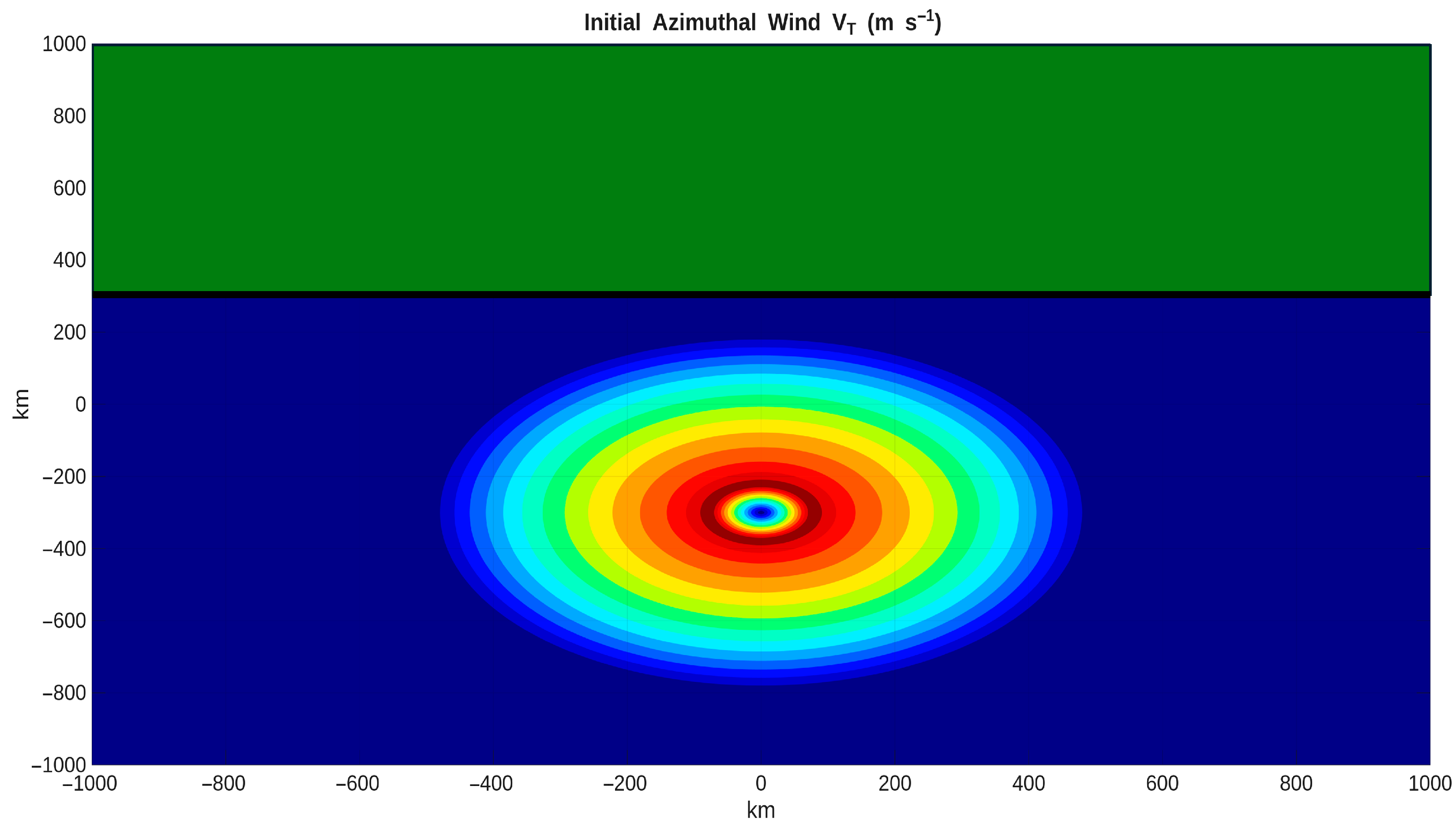

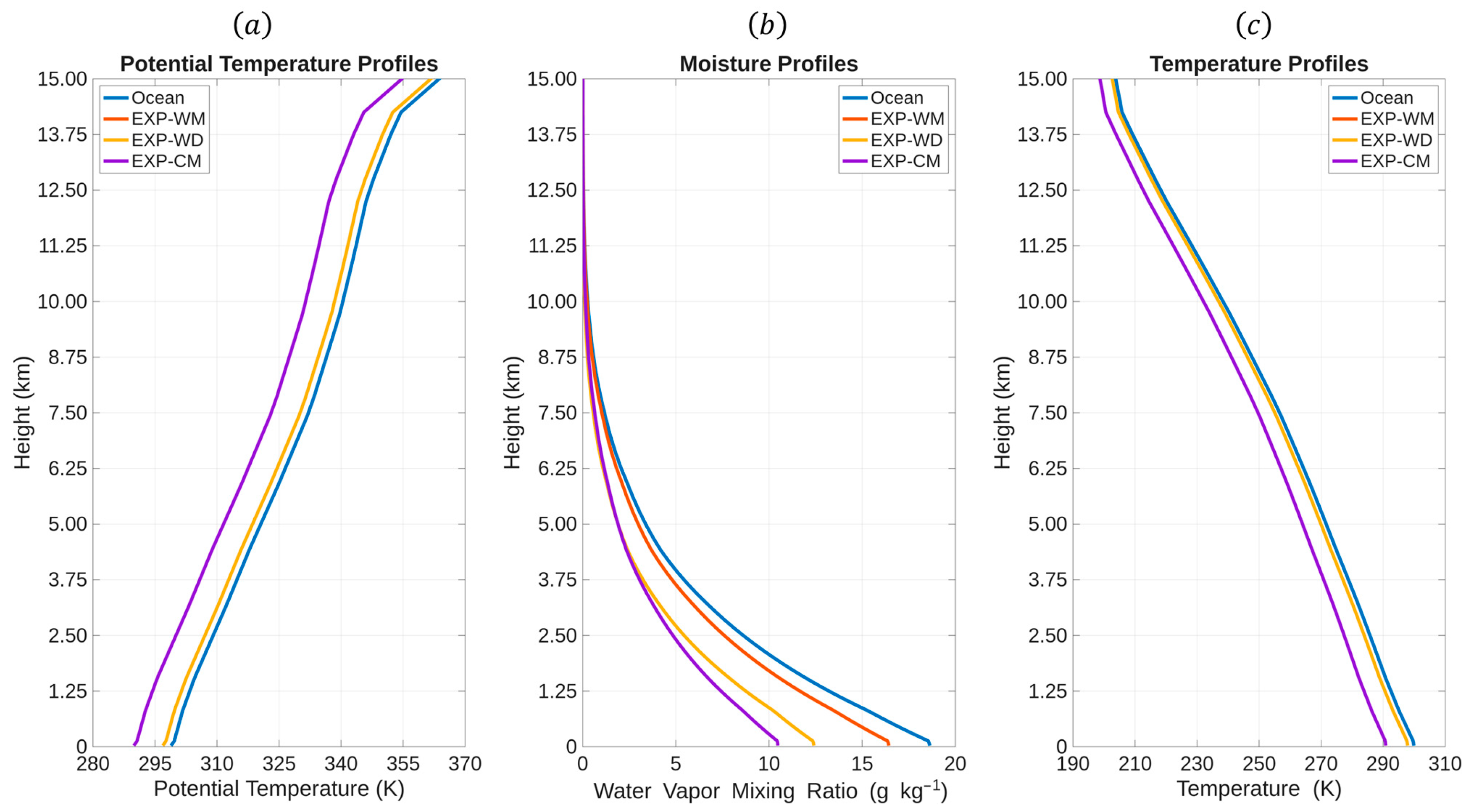
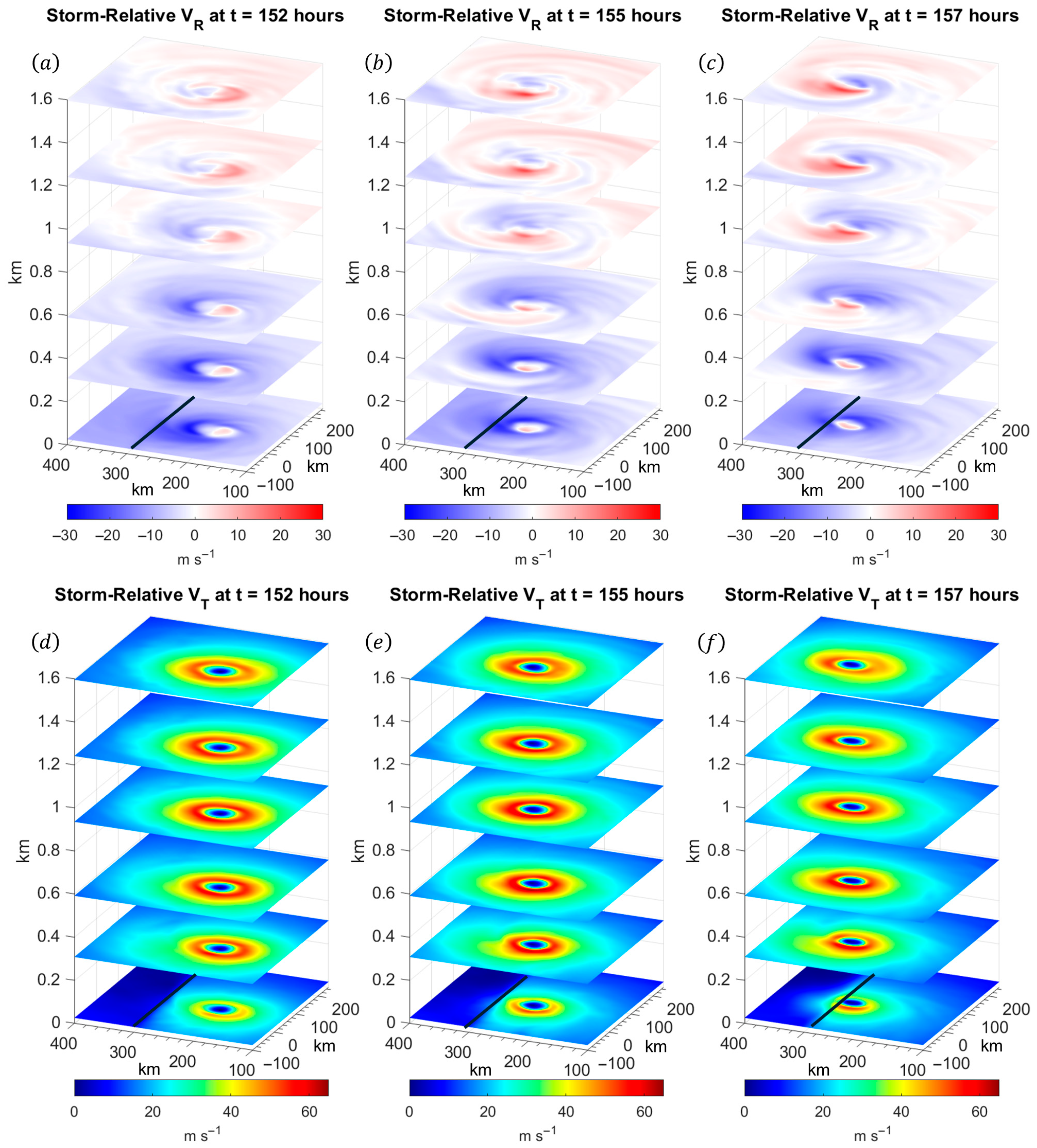


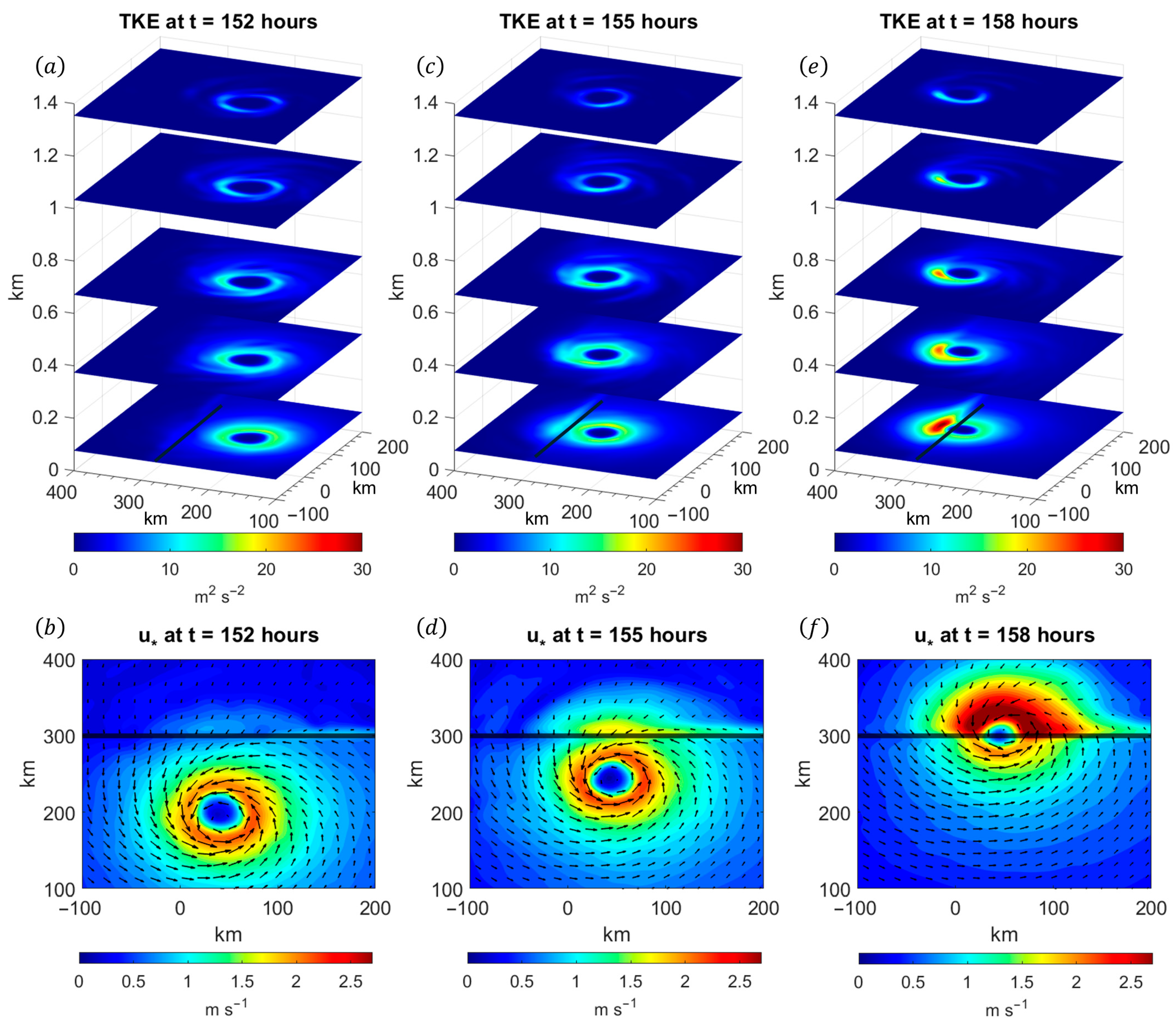

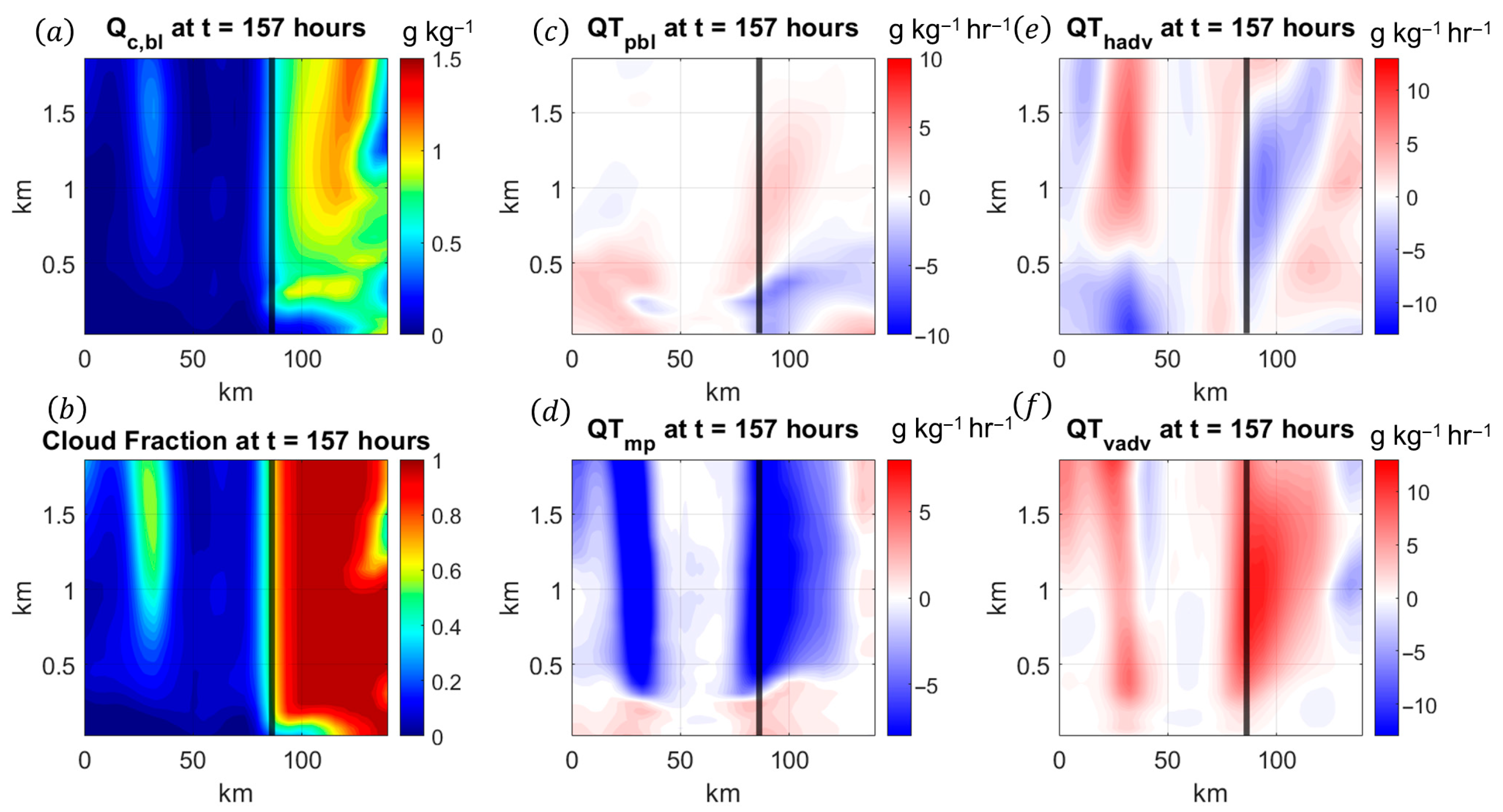
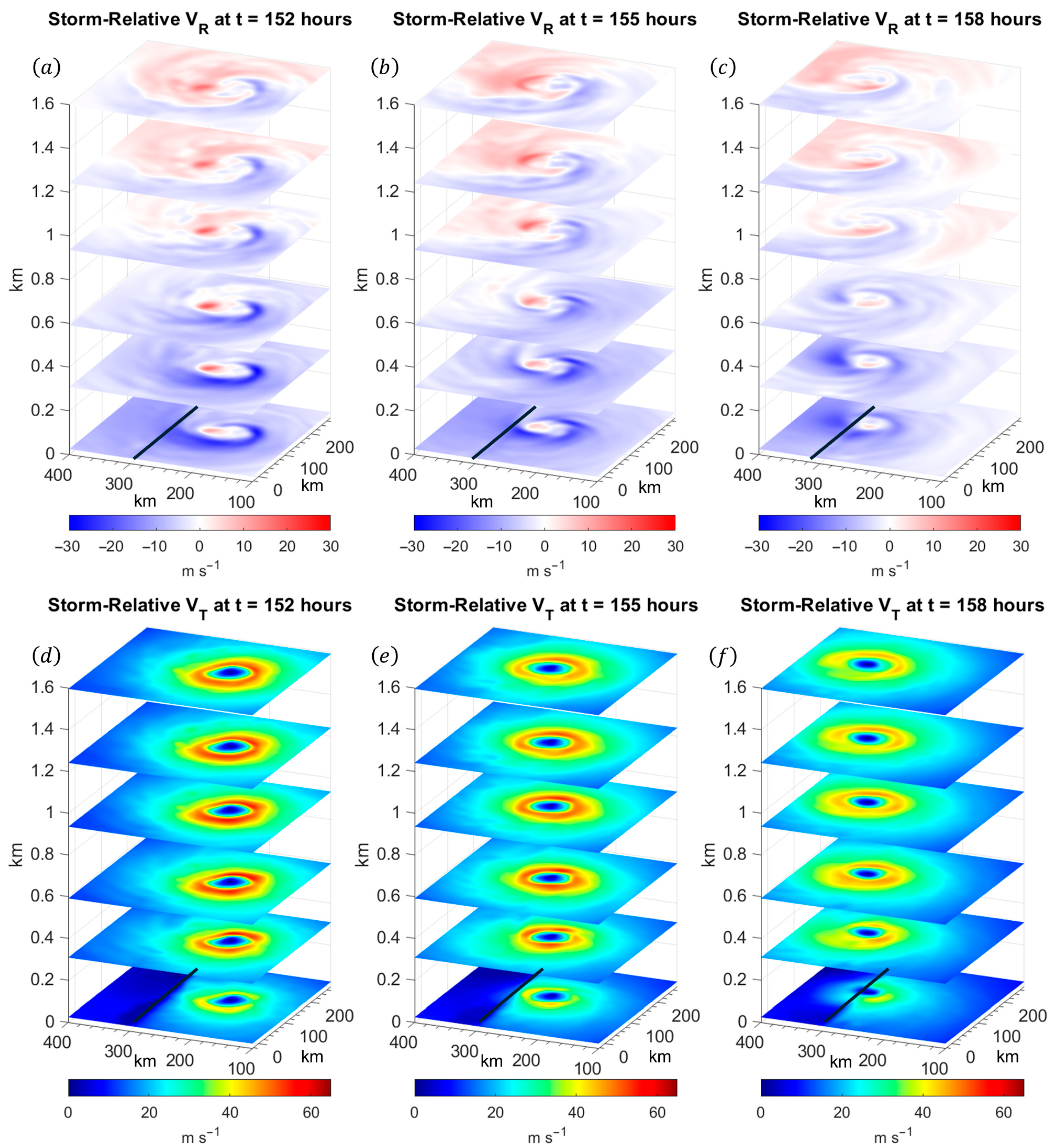
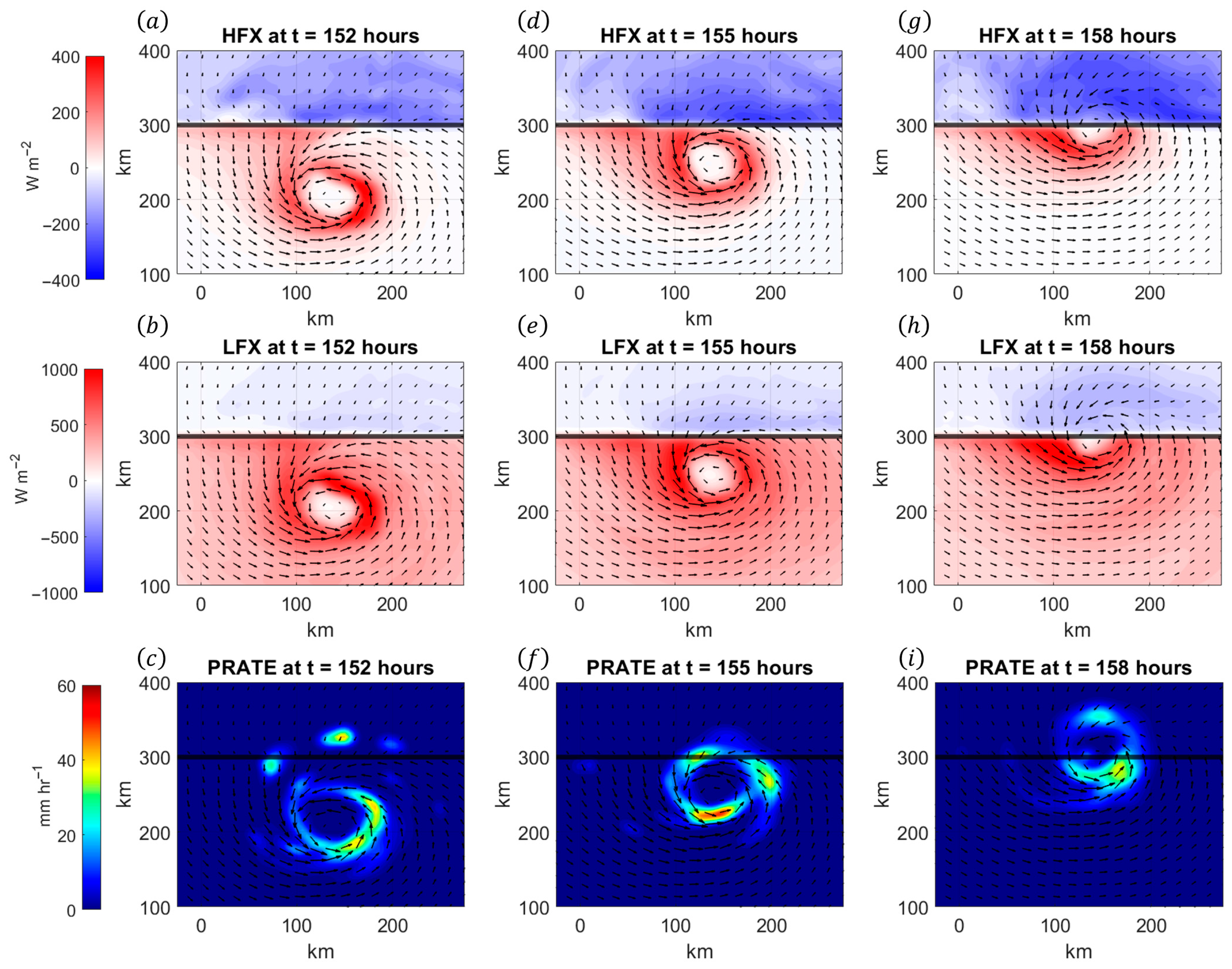
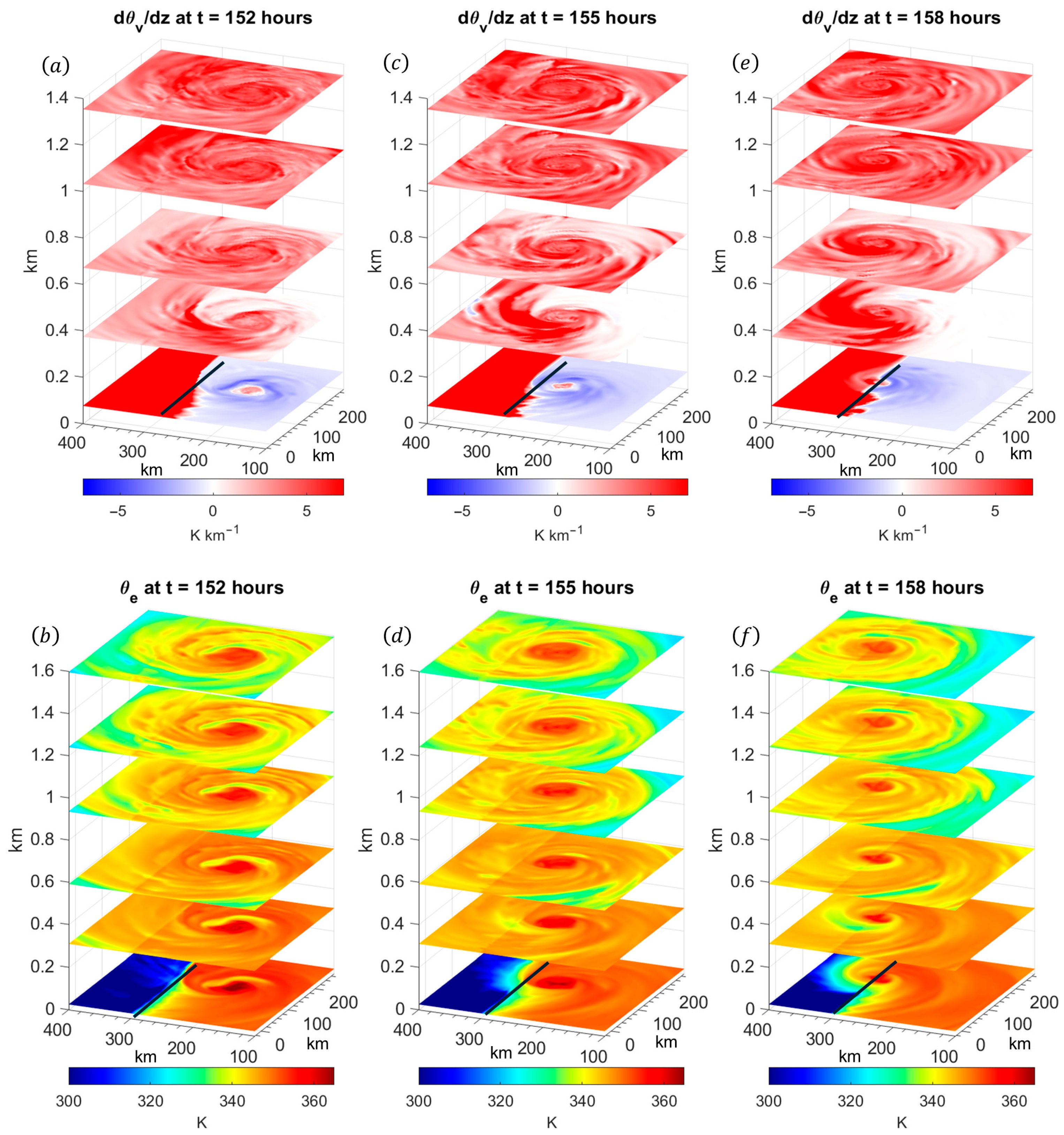
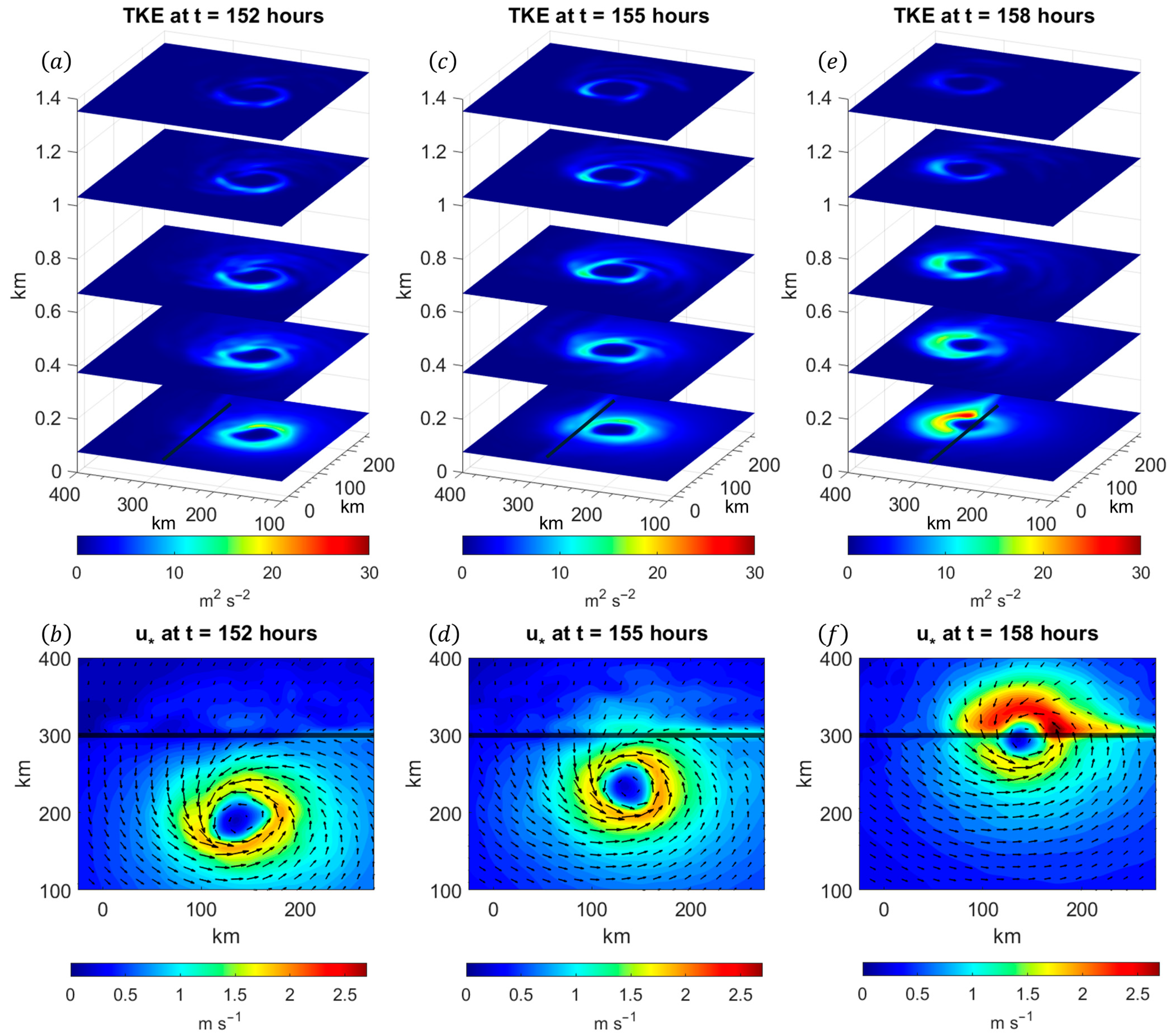
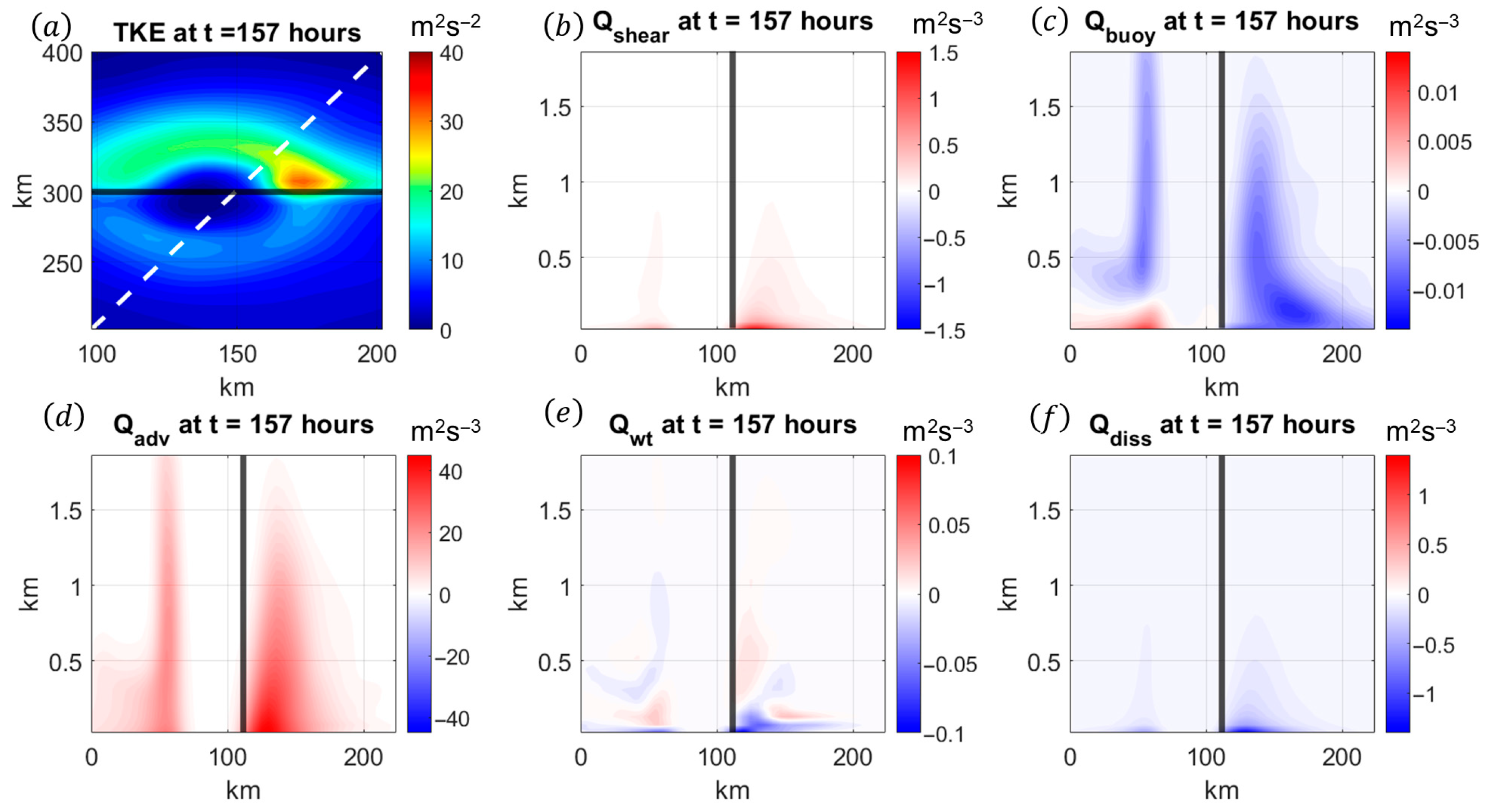
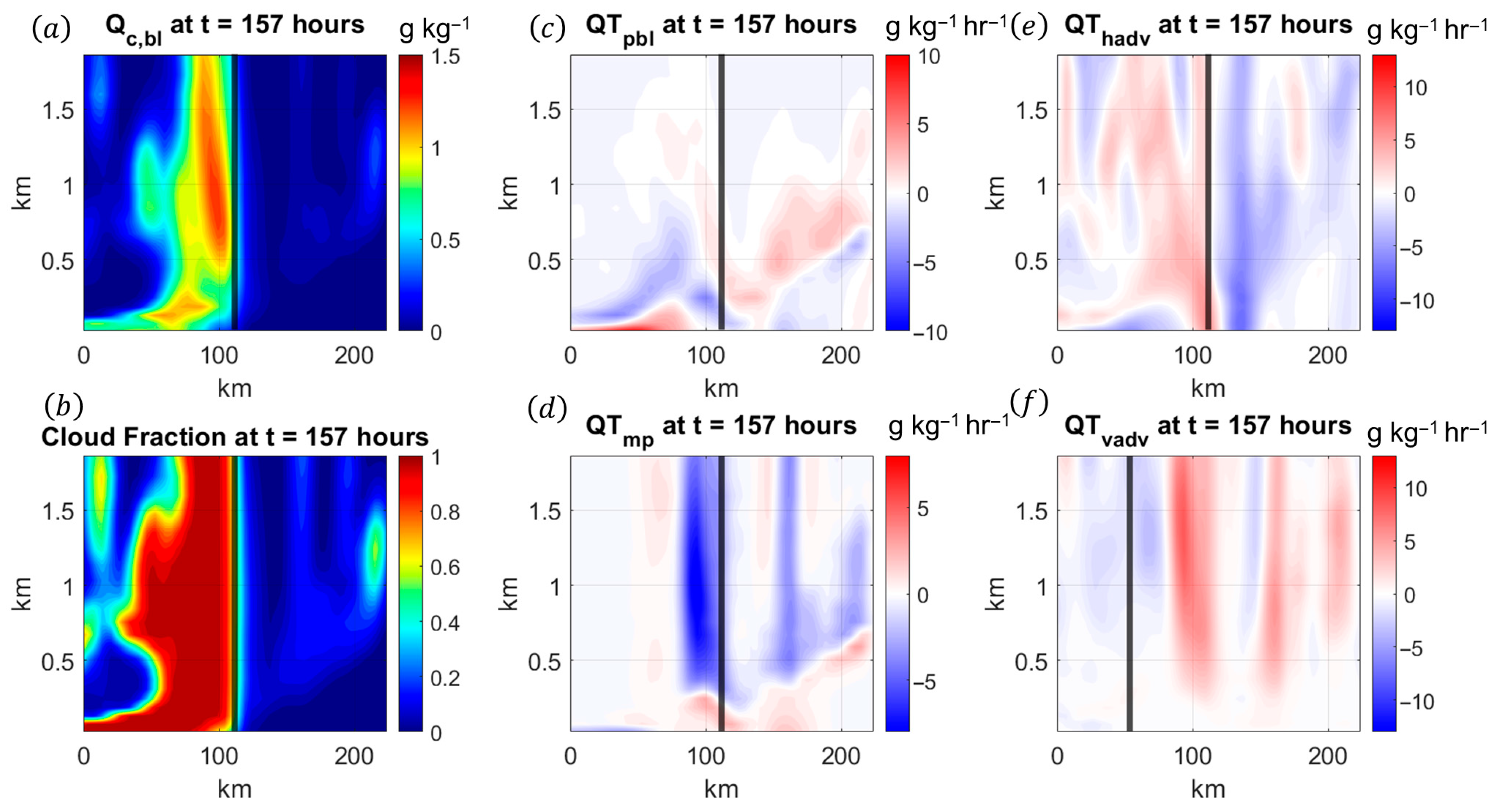
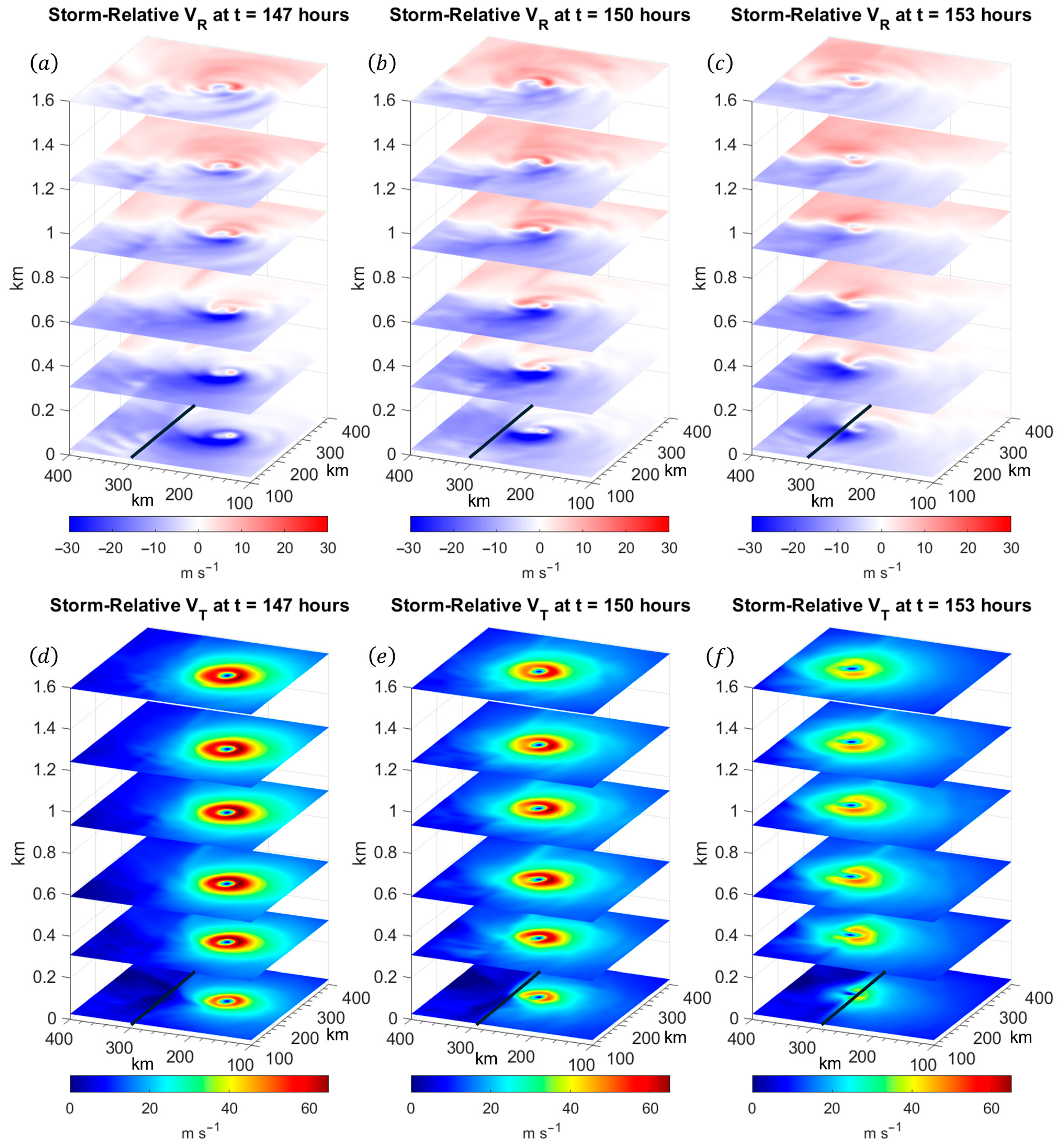

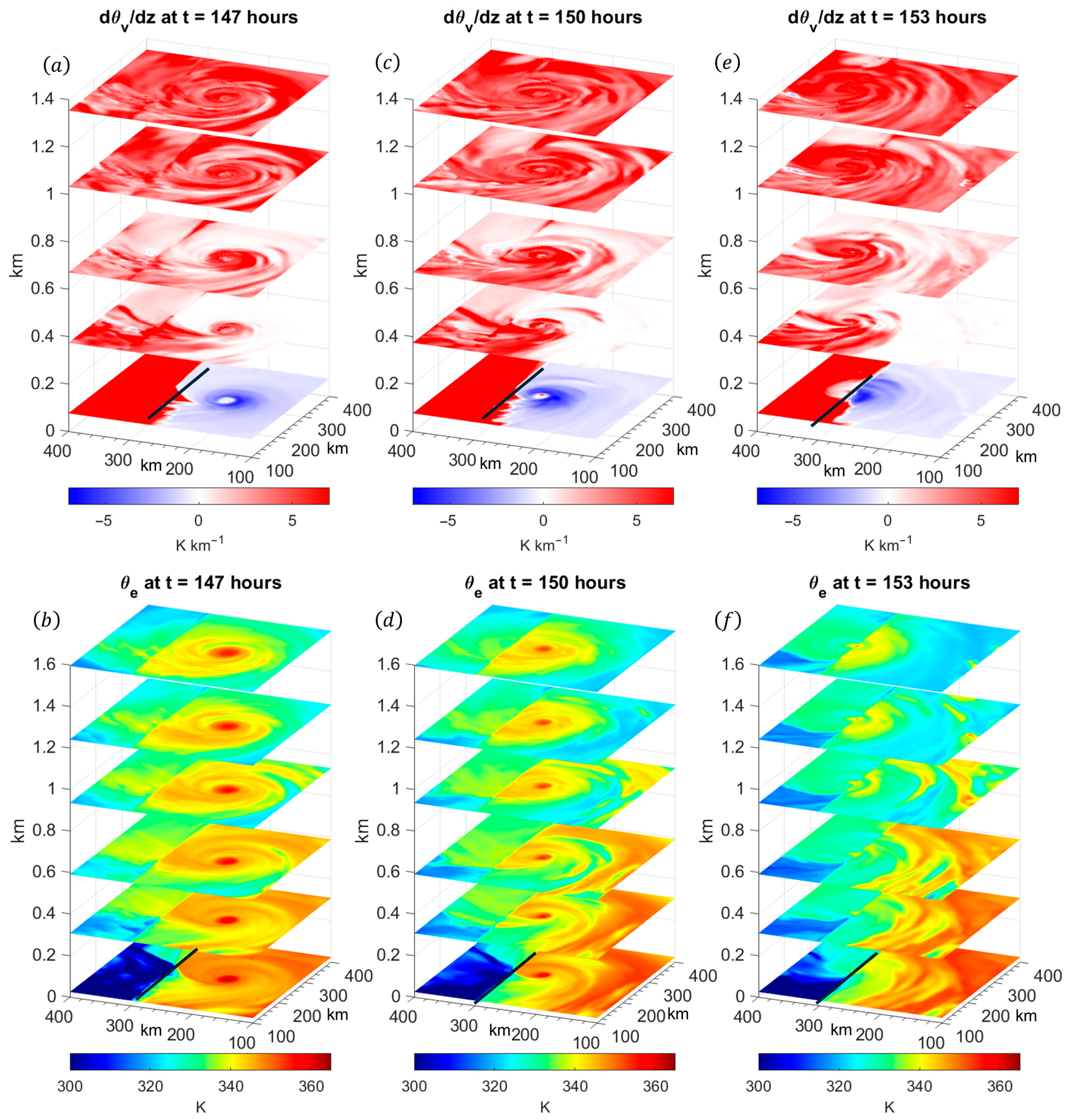
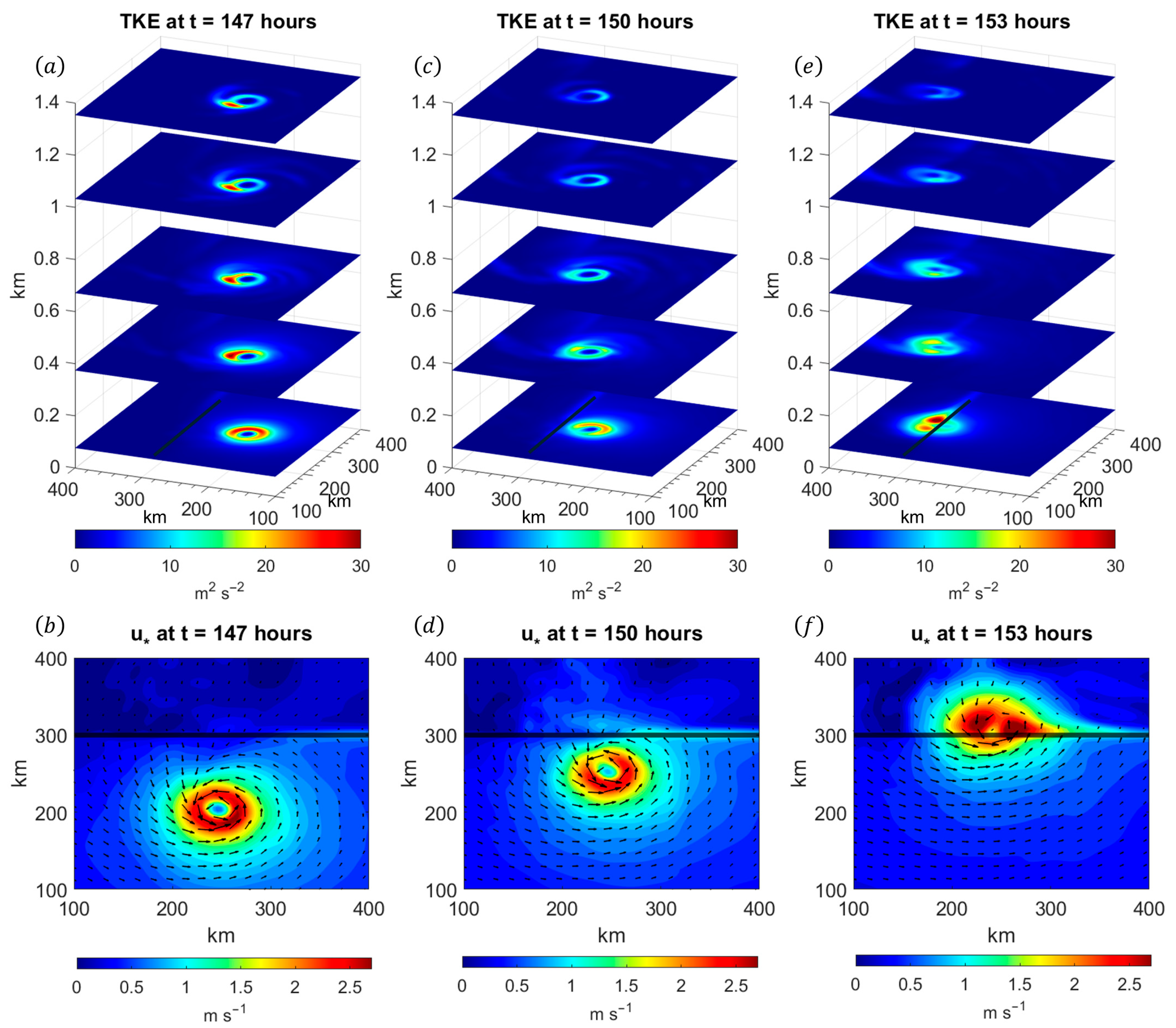
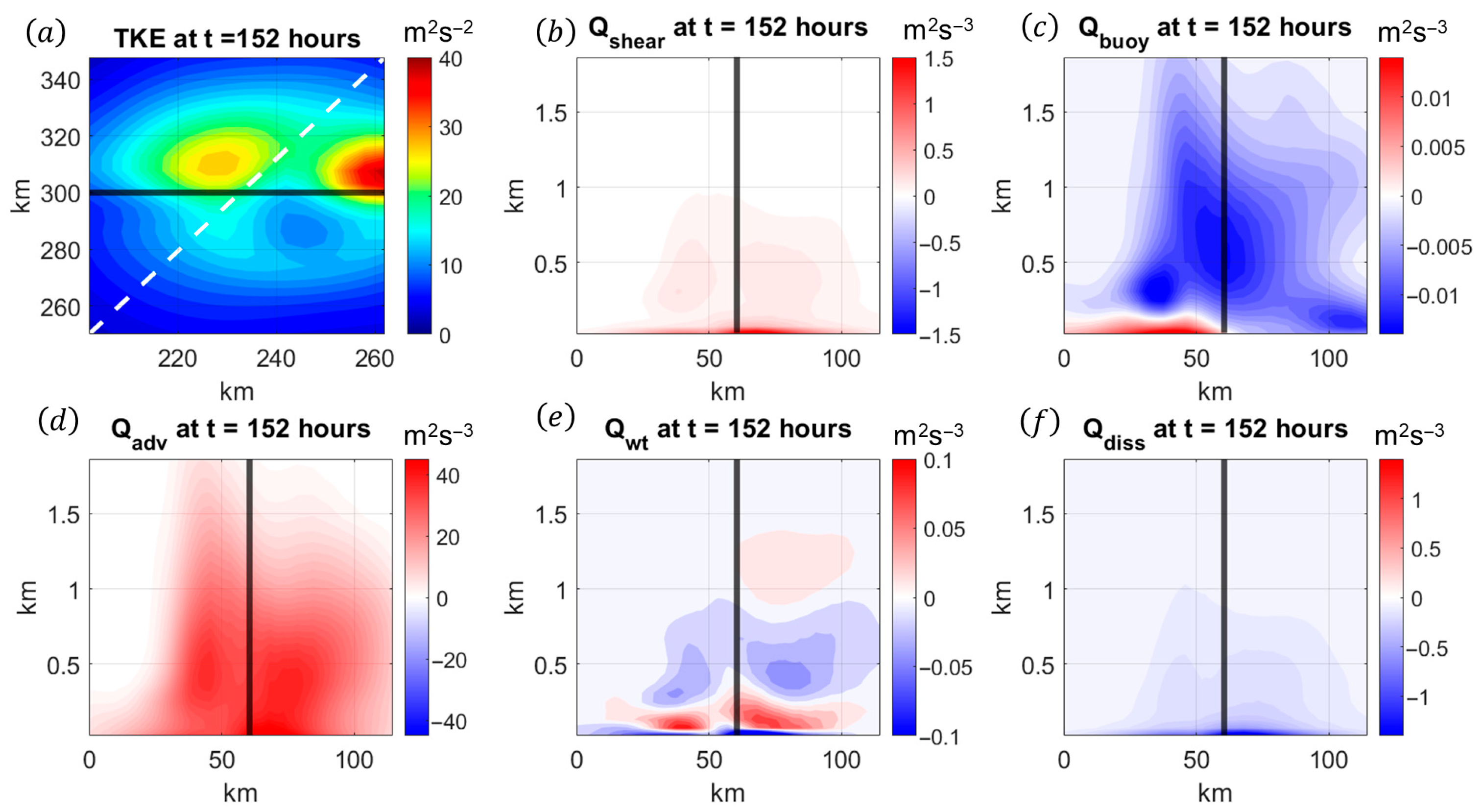
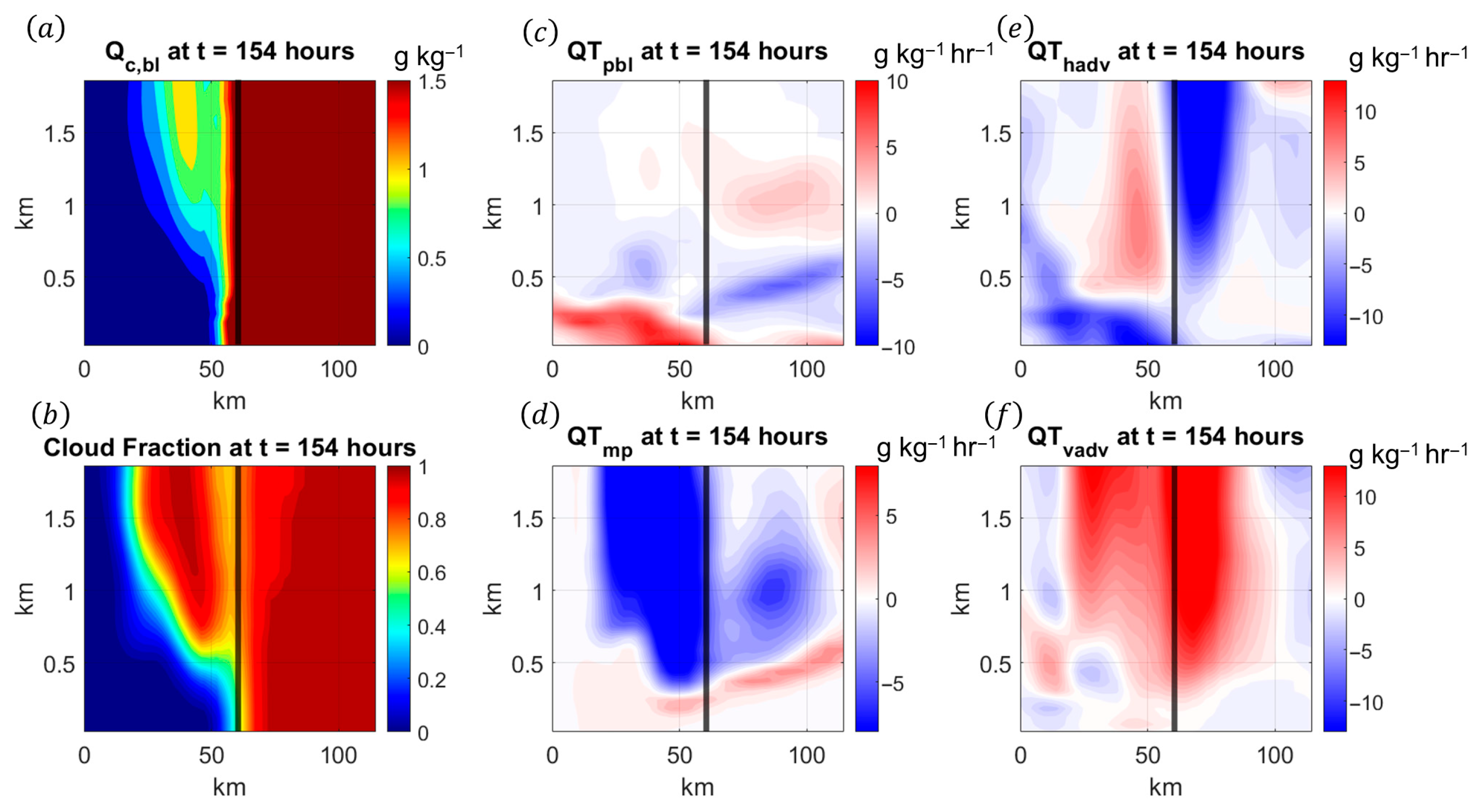
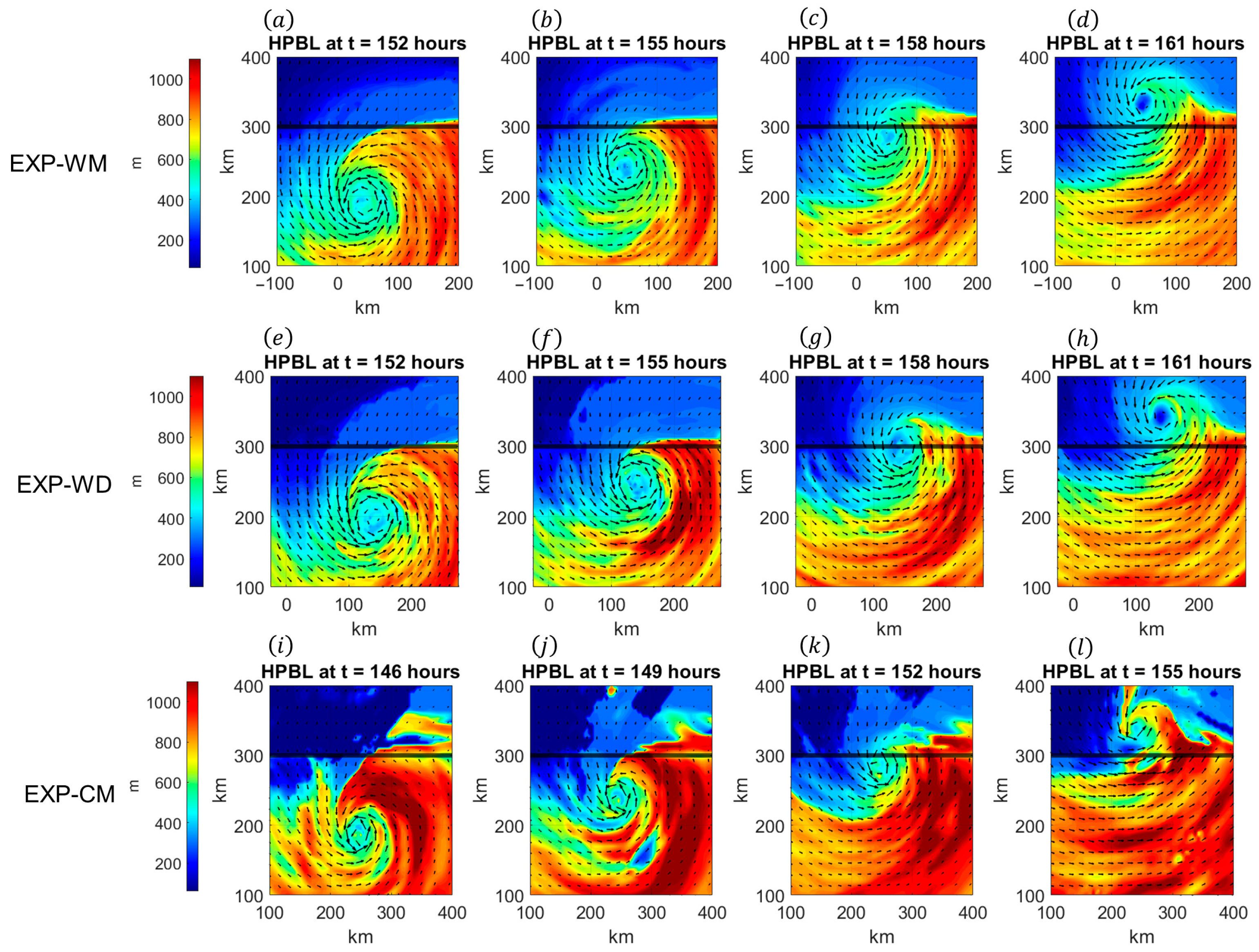
| Vortex | LST (K) | (K) | |
|---|---|---|---|
| EXP-WM | 299 | ||
| EXP-WD | 299 | ||
| EXP-CM | 292 |
Disclaimer/Publisher’s Note: The statements, opinions and data contained in all publications are solely those of the individual author(s) and contributor(s) and not of MDPI and/or the editor(s). MDPI and/or the editor(s) disclaim responsibility for any injury to people or property resulting from any ideas, methods, instructions or products referred to in the content. |
© 2025 by the author. Licensee MDPI, Basel, Switzerland. This article is an open access article distributed under the terms and conditions of the Creative Commons Attribution (CC BY) license (https://creativecommons.org/licenses/by/4.0/).
Share and Cite
Williams, G.J., Jr. The Impact of the Continental Environment on Boundary Layer Evolution for Landfalling Tropical Cyclones. J 2025, 8, 31. https://doi.org/10.3390/j8030031
Williams GJ Jr. The Impact of the Continental Environment on Boundary Layer Evolution for Landfalling Tropical Cyclones. J. 2025; 8(3):31. https://doi.org/10.3390/j8030031
Chicago/Turabian StyleWilliams, Gabriel J., Jr. 2025. "The Impact of the Continental Environment on Boundary Layer Evolution for Landfalling Tropical Cyclones" J 8, no. 3: 31. https://doi.org/10.3390/j8030031
APA StyleWilliams, G. J., Jr. (2025). The Impact of the Continental Environment on Boundary Layer Evolution for Landfalling Tropical Cyclones. J, 8(3), 31. https://doi.org/10.3390/j8030031





